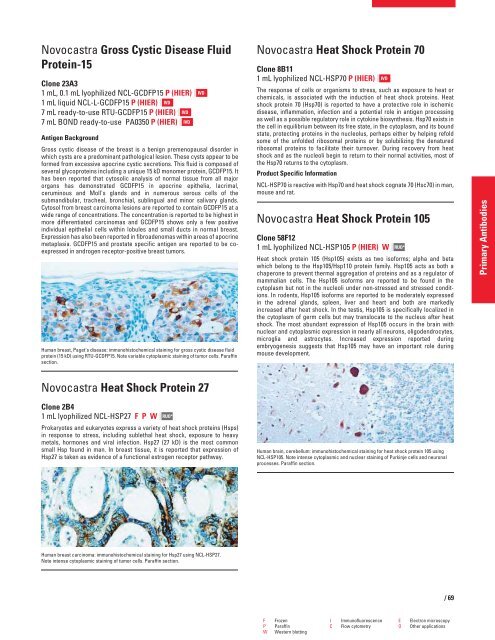QF0159 Marketing Release Record
QF0159 Marketing Release Record
QF0159 Marketing Release Record
You also want an ePaper? Increase the reach of your titles
YUMPU automatically turns print PDFs into web optimized ePapers that Google loves.
Novocastra Gross Cystic Disease Fluid<br />
Protein-15<br />
Clone 23A3<br />
1 mL, 0.1 mL lyophilized NCL-GCDFP15 P (HIER)<br />
1 mL liquid NCL-L-GCDFP15 P (HIER)<br />
7 mL ready-to-use RTU-GCDFP15 P (HIER)<br />
7 mL BOND ready-to-use PA0350 P (HIER)<br />
Antigen Background<br />
Gross cystic disease of the breast is a benign premenopausal disorder in<br />
which cysts are a predominant pathological lesion. These cysts appear to be<br />
formed from excessive apocrine cystic secretions. This fluid is composed of<br />
several glycoproteins including a unique 15 kD monomer protein, GCDFP15. It<br />
has been reported that cytosolic analysis of normal tissue from all major<br />
organs has demonstrated GCDFP15 in apocrine epithelia, lacrimal,<br />
ceruminous and Moll's glands and in numerous serous cells of the<br />
submandibular, tracheal, bronchial, sublingual and minor salivary glands.<br />
Cytosol from breast carcinoma lesions are reported to contain GCDFP15 at a<br />
wide range of concentrations. The concentration is reported to be highest in<br />
more differentiated carcinomas and GCDFP15 shows only a few positive<br />
individual epithelial cells within lobules and small ducts in normal breast.<br />
Expression has also been reported in fibroadenomas within areas of apocrine<br />
metaplasia. GCDFP15 and prostate specific antigen are reported to be coexpressed<br />
in androgen receptor-positive breast tumors.<br />
Human breast, Paget's disease: immunohistochemical staining for gross cystic disease fluid<br />
protein (15 kD) using RTU-GCDFP15. Note variable cytoplasmic staining of tumor cells. Paraffin<br />
section.<br />
Novocastra Heat Shock Protein 27<br />
Clone 2B4<br />
1 mL lyophilized NCL-HSP27 FPW<br />
Prokaryotes and eukaryotes express a variety of heat shock proteins (Hsps)<br />
in response to stress, including sublethal heat shock, exposure to heavy<br />
metals, hormones and viral infection. Hsp27 (27 kD) is the most common<br />
small Hsp found in man. In breast tissue, it is reported that expression of<br />
Hsp27 is taken as evidence of a functional estrogen receptor pathway.<br />
Human breast carcinoma: immunohistochemical staining for Hsp27 using NCL-HSP27.<br />
Note intense cytoplasmic staining of tumor cells. Paraffin section.<br />
IVD<br />
RUO*<br />
IVD<br />
IVD<br />
IVD<br />
Novocastra Heat Shock Protein 70<br />
Clone 8B11<br />
1 mL lyophilized NCL-HSP70 P (HIER)<br />
The response of cells or organisms to stress, such as exposure to heat or<br />
chemicals, is associated with the induction of heat shock proteins. Heat<br />
shock protein 70 (Hsp70) is reported to have a protective role in ischemic<br />
disease, inflammation, infection and a potential role in antigen processing<br />
as well as a possible regulatory role in cytokine biosynthesis. Hsp70 exists in<br />
the cell in equilibrium between its free state, in the cytoplasm, and its bound<br />
state, protecting proteins in the nucleolus, perhaps either by helping refold<br />
some of the unfolded ribosomal proteins or by solubilizing the denatured<br />
ribosomal proteins to facilitate their turnover. During recovery from heat<br />
shock and as the nucleoli begin to return to their normal activities, most of<br />
the Hsp70 returns to the cytoplasm.<br />
Product Specific Information<br />
NCL-HSP70 is reactive with Hsp70 and heat shock cognate 70 (Hsc70) in man,<br />
mouse and rat.<br />
Novocastra Heat Shock Protein 105<br />
Clone 58F12<br />
1 mL lyophilized NCL-HSP105 P (HIER) W<br />
Heat shock protein 105 (Hsp105) exists as two isoforms; alpha and beta<br />
which belong to the Hsp105/Hsp110 protein family. Hsp105 acts as both a<br />
chaperone to prevent thermal aggregation of proteins and as a regulator of<br />
mammalian cells. The Hsp105 isoforms are reported to be found in the<br />
cytoplasm but not in the nucleoli under non-stressed and stressed conditions.<br />
In rodents, Hsp105 isoforms are reported to be moderately expressed<br />
in the adrenal glands, spleen, liver and heart and both are markedly<br />
increased after heat shock. In the testis, Hsp105 is specifically localized in<br />
the cytoplasm of germ cells but may translocate to the nucleus after heat<br />
shock. The most abundant expression of Hsp105 occurs in the brain with<br />
nuclear and cytoplasmic expression in nearly all neurons, oligodendrocytes,<br />
microglia and astrocytes. Increased expression reported during<br />
embryogenesis suggests that Hsp105 may have an important role during<br />
mouse development.<br />
Human brain, cerebellum: immunohistochemical staining for heat shock protein 105 using<br />
NCL-HSP105. Note intense cytoplasmic and nuclear staining of Purkinje cells and neuronal<br />
processes. Paraffin section.<br />
F Frozen I Immunofluorescence E Electron microscopy<br />
P Paraffin C Flow cytometry O Other applications<br />
W Western blotting<br />
IVD<br />
RUO*<br />
/69<br />
Primary Antibodies
















